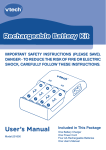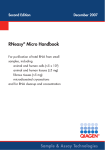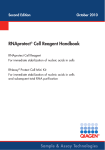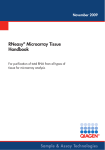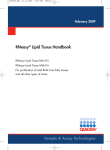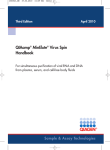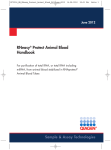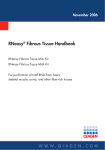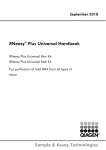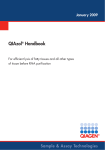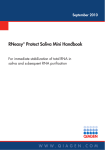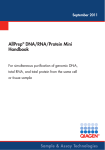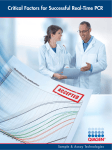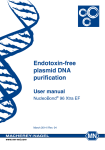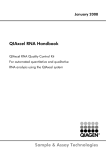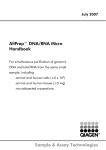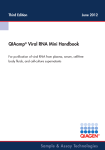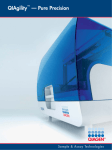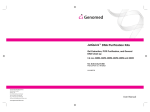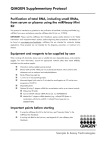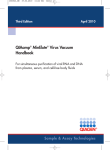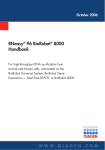Download RNeasy® MinElute® Cleanup Handbook
Transcript
October 2010 December 2005 Second Edition RNeasy® MinElute® Cleanup Handbook For RNA cleanup and concentration with small elution volumes Sample & Assay Technologies QIAGEN Sample and Assay Technologies QIAGEN is the leading provider of innovative sample and assay technologies, enabling the isolation and detection of contents of any biological sample. Our advanced, high-quality products and services ensure success from sample to result. QIAGEN sets standards in: I Purification of DNA, RNA, and proteins I Nucleic acid and protein assays I microRNA research and RNAi I Automation of sample and assay technologies Our mission is to enable you to achieve outstanding success and breakthroughs. For more information, visit www.qiagen.com . Contents Kit Contents 4 Storage 4 Quality Control 4 Product Use Limitations 4 Product Warranty and Satisfaction Guarantee 5 Technical Assistance 5 Safety Information 6 Introduction 7 Principle and procedure 8 Automated purification 8 Equipment and Reagents to Be Supplied by User 9 Protocols RNA Cleanup and Concentration 10 Concentration of RNA Purified Using the PAXgene Blood RNA Kit 13 Troubleshooting Guide 16 Appendix A: General Remarks on Handling RNA 19 Appendix B: Storage, Quantification, and Determination of Quality of RNA 21 Appendix C: DNase Digestion of RNA before RNA Cleanup 24 Appendix D: RNA Cleanup after Lysis and Homogenization with QIAzol Lysis Reagent 25 References 27 Ordering Information 28 RNeasy MinElute Cleanup Handbook 10/2010 3 Kit Contents RNeasy MinElute Cleanup Kit (50) Catalog no. 74204 Number of preps 50 RNeasy MinElute Spin Columns (each in a 2 ml Collection Tube) 50 Collection Tubes (1.5 ml) 50 Collection Tubes (2 ml) 100 Buffer RLT* 45 ml Buffer RPE† (concentrate) 11 ml RNase-Free Water 10 ml Handbook 1 * Contains a guanidine salt. Not compatible with disinfecting reagents containing bleach. See page 6 for safety information. † Before using for the first time, add 4 volumes of ethanol (96–100%) as indicated on the bottle to obtain a working solution. Storage Store RNeasy MinElute spin columns immediately upon receipt at 2–8°C. Store the remaining components of the RNeasy MinElute Cleanup Kit dry at room temperature (15–25°C). All components of the kit are stable for at least 9 months under these conditions. Quality Control In accordance with QIAGEN’s ISO-certified Quality Management System, each lot of RNeasy MinElute Cleanup Kit is tested against predetermined specifications to ensure consistent product quality. Product Use Limitations The RNeasy MinElute Cleanup Kit is intended for molecular biology applications. This product is not intended for the diagnosis, prevention, or treatment of a disease. All due care and attention should be exercised in the handling of the products. We recommend all users of QIAGEN® products to adhere to the NIH guidelines that have been developed for recombinant DNA experiments, or to other applicable guidelines. 4 RNeasy MinElute Cleanup Handbook 10/2010 Product Warranty and Satisfaction Guarantee QIAGEN guarantees the performance of all products in the manner described in our product literature. The purchaser must determine the suitability of the product for its particular use. Should any product fail to perform satisfactorily due to any reason other than misuse, QIAGEN will replace it free of charge or refund the purchase price. We reserve the right to change, alter, or modify any product to enhance its performance and design. If a QIAGEN product does not meet your expectations, simply call your local Technical Service Department or distributor. We will credit your account or exchange the product — as you wish. Separate conditions apply to QIAGEN scientific instruments, service products, and to products shipped on dry ice. Please inquire for more information. A copy of QIAGEN terms and conditions can be obtained on request, and is also provided on the back of our invoices. If you have questions about product specifications or performance, please call QIAGEN Technical Services or your local distributor (see back cover or visit www.qiagen.com ). Technical Assistance At QIAGEN, we pride ourselves on the quality and availability of our technical support. Our Technical Service Departments are staffed by experienced scientists with extensive practical and theoretical expertise in sample and assay technologies and the use of QIAGEN products. If you have any questions or experience any difficulties regarding the RNeasy MinElute Cleanup Kit or QIAGEN products in general, please do not hesitate to contact us. QIAGEN customers are a major source of information regarding advanced or specialized uses of our products. This information is helpful to other scientists as well as to the researchers at QIAGEN. We therefore encourage you to contact us if you have any suggestions about product performance or new applications and techniques. For technical assistance and more information, please see our Technical Support Center at www.qiagen.com/Support or call one of the QIAGEN Technical Service Departments or local distributors (see back cover or visit www.qiagen.com ). RNeasy MinElute Cleanup Handbook 10/2010 5 Safety Information When working with chemicals, always wear a suitable lab coat, disposable gloves, and protective goggles. For more information, please consult the appropriate material safety data sheets (MSDSs). These are available online in convenient and compact PDF format at www.qiagen.com/Support/MSDS.aspx where you can find, view, and print the MSDS for each QIAGEN kit and kit component. CAUTION: DO NOT add bleach or acidic solutions directly to the sample-preparation waste. Buffer RLT contains guanidine thiocyanate, which can form highly reactive compounds when combined with bleach. If liquid containing this buffer is spilt, clean with suitable laboratory detergent and water. If the spilt liquid contains potentially infectious agents, clean the affected area first with laboratory detergent and water, and then with 1% (v/v) sodium hypochlorite. The following risk and safety phrases apply to the components of the RNeasy MinElute Cleanup Kit. Buffer RLT Contains guanidine thiocyanate: R20/21/22-32, S13-26-36-46 harmful. Risk and safety phrases:* 24-hour emergency information Emergency medical information in English, French, and German can be obtained 24 hours a day from: Poison Information Center Mainz, Germany Tel: +49-6131-19240 * R20/21/22: Harmful by inhalation, in contact with skin and if swallowed; R32: Contact with acids liberates very toxic gas; S13: Keep away from food, drink and animal feedingstuffs; S26: In case of contact with eyes, rinse immediately with plenty of water and seek medical advice; S36: Wear suitable protective clothing; S46: If swallowed, seek medical advice immediately and show the container or label. 6 RNeasy MinElute Cleanup Handbook 10/2010 Introduction The RNeasy MinElute Cleanup Kit uses novel technology to purify and concentrate RNA. RNA amounts from 45 µg down to a few picograms, which correspond to less than 1 cell, can be purified from enzymatic reactions (e.g., in vitro transcription, DNase digestion, RNA labeling) or from RNA samples requiring desalting (e.g., after phenol extraction and ethanol precipitation). The kit allows minimal elution volumes, making it well-suited for concentration of RNA (e.g., after RNA purification with the RNeasy Mini Kit or PAXgene™ Blood RNA Kit). QIAGEN provides a wide range of other kits for purification of total RNA from different sample sources; for details, visit www.qiagen.com/RNA . RNeasy MinElute Cleanup Procedure Add Buffer RLT and ethanol Bind RNA RNA Wash Elute Concentrated RNA solution RNeasy MinElute Cleanup Handbook 10/2010 7 Principle and procedure RNeasy MinElute technology combines the selective binding properties of a silicabased membrane with the speed of microspin technology. Guanidinethiocyanate–containing lysis buffer and ethanol are added to the sample to create conditions that promote selective binding of RNA to the silica membrane of the RNeasy MinElute spin column. The sample is then applied to the RNeasy MinElute spin column. RNA binds to the silica membrane, contaminants are efficiently washed away, and high-quality RNA is eluted in RNase-free water (see flowchart). With the RNeasy MinElute procedure, all RNA molecules longer than 200 nucleotides are purified. The procedure provides an enrichment for mRNA since most RNAs <200 nucleotides (such as 5.8S rRNA, 5S rRNA, and tRNAs, which together comprise 15–20% of total RNA) are selectively excluded. The size distribution of the purified RNA is comparable to that obtained by centrifugation through a CsCl cushion, where small RNAs do not sediment efficiently.* Automated purification Purification of RNA can be fully automated on the QIAcube®. The innovative QIAcube uses advanced technology to process QIAGEN spin columns, enabling seamless integration of automated, low-throughput sample prep into your laboratory workflow. Sample preparation using the QIAcube follows the same steps as the manual procedure (i.e., bind, wash, and elute), enabling you to continue using the RNeasy MinElute Cleanup Kit for cleanup of high-quality RNA. For more information about the automated procedure, see the relevant protocol sheet available at www.qiagen.com/MyQIAcube . The QIAcube is preinstalled with protocols for purification of plasmid DNA, genomic DNA, RNA, viral nucleic acids, and proteins, plus DNA and RNA cleanup. The range of protocols available is continually expanding, and additional QIAGEN protocols can be downloaded free of charge at www.qiagen.com/MyQIAcube . * For purification of miRNA and total RNA from a wide range of cells and tissues, we recommend using miRNeasy Kits. For details, visit www.qiagen.com/miRNA . 8 RNeasy MinElute Cleanup Handbook 10/2010 Equipment and Reagents to Be Supplied by User When working with chemicals, always wear a suitable lab coat, disposable gloves, and protective goggles. For more information, consult the appropriate material safety data sheets (MSDSs), available from the product supplier. For all protocols I Sterile, RNase-free pipet tips I Microcentrifuge (with rotor for 2 ml tubes) I Ethanol (80% and 96–100%)* I Disposable gloves I Optional: 14.3 M β-mercaptoethanol (β-ME) (commercially available solutions are usually 14.3 M) or, alternatively, 2 M dithiothreitol (DTT) in water For concentration of RNA purified using the PAXgene Blood RNA Kit I Elution Buffer BR5 (included in the PAXgene Blood RNA Kit) I Heating block or water bath capable of reaching 65°C * Do not use denatured alcohol, which contains other substances such as methanol or methylethylketone. RNeasy MinElute Cleanup Handbook 10/2010 9 RNA Cleanup Protocol: RNA Cleanup and Concentration This protocol is designed for cleaning up RNA from enzymatic reactions, for desalting RNA samples, and for concentrating RNA isolated by various methods. For concentration of total cellular RNA purified using the PAXgene Blood RNA Kit, follow the protocol on page 13. Determining the correct amount of starting material A maximum of 45 µg RNA in a maximum volume of 200 µl can be cleaned up in this protocol. This amount corresponds to the binding capacity of the RNeasy MinElute spin column. Do not overload the column as this will significantly reduce RNA yield and purity. Important points before starting I If preparing RNA for the first time, read Appendix A (page 19). I Generally, DNase digestion is not required since RNeasy MinElute silicamembrane technology efficiently removes most of the DNA without DNase treatment. However, further DNA removal may be necessary for certain RNA applications that are sensitive to very small amounts of DNA (e.g., TaqMan® RT-PCR analysis with a low-abundance target). In these cases, DNA can be removed by a DNase digestion before starting RNA cleanup (see Appendix C, page 24). I Buffer RLT contains a guanidine salt and is therefore not compatible with disinfecting reagents containing bleach. See page 6 for safety information. I Perform all steps of the procedure at room temperature (15–25°C). During the procedure, work quickly. I Perform all centrifugation steps at 20–25°C in a standard microcentrifuge. Ensure that the centrifuge does not cool below 20°C. I In the procedure below, 왖 refers to use of starting volumes ⱕ100 µl, and 쎲 refers to use of starting volumes of 100–200 µl. Things to do before starting I Buffer RPE is supplied as a concentrate. Before using for the first time, add 4 volumes of ethanol (96–100%) as indicated on the bottle to obtain a working solution. I Buffer RLT may form a precipitate during storage. If necessary, redissolve by warming, and then place at room temperature (15–25°C). 10 RNeasy MinElute Cleanup Handbook 10/2010 I Procedure 1. Adjust the sample to a volume of 왖 100 µl or 쎲 200 µl with RNase-free water. Add 왖 350 µl or 쎲 700 µl Buffer RLT, and mix well. If starting with an RNA pellet, be sure that the pellet is dissolved in the RNase-free water (supplied) before adding Buffer RLT. Optional: Add β-ME (or DTT) to Buffer RLT before use (see “Things to do before starting”). 2. Add 왖 250 µl or 쎲 500 µl of 96–100% ethanol to the diluted RNA, and mix well by pipetting. Do not centrifuge. Proceed immediately to step 3. 3. Transfer the sample (700 µl) to an RNeasy MinElute spin column placed in a 2 ml collection tube (supplied). Close the lid gently, and centrifuge for 15 s at ⱖ8000 x g (ⱖ10,000 rpm). Discard the flow-through.* For 쎲 samples >700 µl, transfer the remaining sample (up to 700 µl) and repeat the centrifugation. Discard the flow-through.* 4. Place the RNeasy MinElute spin column in a new 2 ml collection tube (supplied). Add 500 µl Buffer RPE to the spin column. Close the lid gently, and centrifuge for 15 s at ⱖ8000 x g (ⱖ10,000 rpm) to wash the spin column membrane. Discard the flow-through. Reuse the collection tube in step 5. Note: Buffer RPE is supplied as a concentrate. Ensure that ethanol is added to Buffer RPE before use (see “Things to do before starting”). 5. Add 500 µl of 80% ethanol to the RNeasy MinElute spin column. Close the lid gently, and centrifuge for 2 min at ⱖ8000 x g (ⱖ10,000 rpm) to wash the spin column membrane. Discard the flow-through and collection tube. Note: After centrifugation, carefully remove the RNeasy MinElute spin column from the collection tube so that the column does not contact the flow-through. Otherwise, carryover of ethanol will occur. * Flow-through contains Buffer RLT and is therefore not compatible with bleach. See page 6 for safety information. RNeasy MinElute Cleanupi Handbook 10/2010 11 RNA Cleanup Optional: If cleaning up crude RNA preps (e.g., after salting-out methods) or samples rich in RNases, we recommend adding β-mercaptoethanol (β-ME) to Buffer RLT before use. Add 10 µl β-ME per 1 ml Buffer RLT. Dispense in a fume hood and wear appropriate protective clothing. Buffer RLT containing β-ME can be stored at room temperature for up to 1 month. Alternatively, add 20 µl of 2 M dithiothreitol (DTT) per 1 ml Buffer RLT. The stock solution of 2 M DTT in water should be prepared fresh, or frozen in single-use aliquots. Buffer RLT containing DTT can be stored at room temperature for up to 1 month. RNA Cleanup 6. Place the RNeasy MinElute spin column in a new 2 ml collection tube (supplied). Open the lid of the spin column, and centrifuge at full speed for 5 min. Discard the flow-through and collection tube. To avoid damage to their lids, place the spin columns into the centrifuge with at least one empty position between columns. Orient the lids so that they point in a direction opposite to the rotation of the rotor (e.g., if the rotor rotates clockwise, orient the lids counterclockwise). It is important to dry the spin column membrane since residual ethanol may interfere with downstream reactions. Centrifugation with the lids open ensures that no ethanol is carried over during RNA elution. 7. Place the RNeasy MinElute spin column in a new 1.5 ml collection tube (supplied). Add 14 µl RNase-free water directly to the center of the spin column membrane. Close the lid gently, and centrifuge for 1 min at full speed to elute the RNA. As little as 10 µl RNase-free water can be used for elution if a higher RNA concentration is required, but the yield will be reduced by approximately 20%. Do not elute with less than 10 µl RNase-free water as the spin column membrane will not be sufficiently hydrated. The dead volume of the RNeasy MinElute spin column is 2 µl: elution with 14 µl RNase-free water results in a 12 µl eluate. For RT-PCR and real-time RT-PCR with the purified RNA, QIAGEN offers a range of optimized, ready-to-use kits that provide highly specific and sensitive results. For details, visit www.qiagen.com/PCR . For whole transcriptome amplification (WTA) of limited amounts of RNA, we recommend the QuantiTect® Whole Transcriptome Kit. For details, visit www.qiagen.com/goto/WTA . 12 RNeasy MinElute Cleanup Handbook 10/2010 Protocol: Concentration of RNA Purified Using the PAXgene Blood RNA Kit This protocol is for the concentration of total cellular RNA purified using the PAXgene Blood RNA Kit (see page 28 for ordering information). Determining the correct amount of starting material Important points before starting I The RNA denaturation step (65°C incubation for 5 min) of the PAXgene Blood RNA Kit protocol does not need to be performed. RNA denaturation takes place in the last step of this protocol. I Elution buffer BR5 (included in the PAXgene Blood RNA Kit) is required for RNA elution in this protocol. I If preparing RNA for the first time, read Appendix A (page 19). I DNase digestion does not need to be performed in this protocol because it has already been carried out in the PAXgene Blood RNA Kit protocol. I Buffer RLT contains a guanidine salt and is therefore not compatible with disinfecting reagents containing bleach. See page 6 for safety information. I Unless otherwise indicated, perform all steps of the procedure at room temperature (15–25°C). During the procedure, work quickly. I Perform all centrifugation steps at 20–25°C in a standard microcentrifuge. Ensure that the centrifuge does not cool below 20°C. I In the procedure below, 왖 refers to use of starting volumes ⱕ100 µl, and 쎲 refers to use of starting volumes of 100–200 µl. Things to do before starting I Buffer RPE is supplied as a concentrate. Before using for the first time, add 4 volumes of ethanol (96–100%) as indicated on the bottle to obtain a working solution. I Buffer RLT may form a precipitate during storage. If necessary, redissolve by warming, and then place at room temperature (15–25°C). RNeasy MinElute Cleanup Handbook 10/2010 13 RNA Cleanup PAXgene A maximum of 45 µg RNA in a maximum volume of 200 µl can be concentrated in this protocol. This amount corresponds to the binding capacity of the RNeasy MinElute spin column. Before starting the procedure, RNA eluates obtained with the PAXgene Blood RNA Kit can be pooled as long as the total amount of RNA is ⱕ45 µg and the total volume is ⱕ200 µl. RNA Cleanup PAXgene Procedure 1. Heat a heating block or water bath to 65°C for use in step 9. 2. Adjust the sample to a volume of 왖 100 µl or 쎲 200 µl with RNase-free water. Add 왖 350 µl or 쎲 700 µl Buffer RLT, and mix well. 3. Add 왖 250 µl or 쎲 500 µl of 96–100% ethanol to the diluted RNA, and mix well by pipetting. Do not centrifuge. Proceed immediately to step 4. 4. Transfer the sample (700 µl) to an RNeasy MinElute spin column placed in a 2 ml collection tube (supplied). Close the lid gently, and centrifuge for 15 s at ⱖ8000 x g (ⱖ10,000 rpm). Discard the flow-through.* For 쎲 samples >700 µl, transfer the remaining sample (up to 700 µl) and repeat the centrifugation. Discard the flow-through.* 5. Place the RNeasy MinElute spin column in a new 2 ml collection tube (supplied). Add 500 µl Buffer RPE to the spin column. Close the lid gently, and centrifuge for 15 s at ⱖ8000 x g (ⱖ10,000 rpm) to wash the spin column membrane. Discard the flow-through. Reuse the collection tube in step 6. Note: Buffer RPE is supplied as a concentrate. Ensure that ethanol is added to Buffer RPE before use (see “Things to do before starting”). 6. Add 500 µl of 80% ethanol to the RNeasy MinElute spin column. Close the lid gently, and centrifuge for 2 min at ⱖ8000 x g (ⱖ10,000 rpm) to wash the spin column membrane. Discard the flow-through and collection tube. Note: After centrifugation, carefully remove the RNeasy MinElute spin column from the collection tube so that the column does not contact the flow-through. Otherwise, carryover of ethanol will occur. 7. Place the RNeasy MinElute spin column in a new 2 ml collection tube (supplied). Open the lid of the spin column, and centrifuge at full speed for 5 min. Discard the flow-through and collection tube. To avoid damage to their lids, place the spin columns into the centrifuge with at least one empty position between columns. Orient the lids so that they point in a direction opposite to the rotation of the rotor (e.g., if the rotor rotates clockwise, orient the lids counterclockwise). It is important to dry the spin column membrane since residual ethanol may interfere with downstream reactions. Centrifugation with the lids open ensures that no ethanol is carried over during RNA elution. * Flow-through contains Buffer RLT and is therefore not compatible with bleach. See page 6 for safety information. 14 RNeasy MinElute Cleanup Handbook 10/2010 8. Place the RNeasy MinElute spin column in a new 1.5 ml collection tube (supplied). Add 14 µl of elution buffer BR5 (from the PAXgene Blood RNA Kit) directly to the center of the spin column membrane. Close the lid gently, and centrifuge for 1 min at full speed to elute the RNA. The dead volume of the RNeasy MinElute spin column is 2 µl: elution with 14 µl elution buffer BR5 results in a 12 µl eluate. 9. Incubate the eluate for 5 min at 65°C in a heating block or water bath. After incubation, chill immediately on ice. Denaturation of the eluate is essential for maximum efficiency in downstream applications such as RT-PCR, other amplification reactions, or cDNA synthesis. It is not necessary to denature samples more than once, and samples remain denatured after freezing and thawing. For RT-PCR and real-time RT-PCR with the purified RNA, QIAGEN offers a range of optimized, ready-to-use kits that provide highly specific and sensitive results. For details, visit www.qiagen.com/PCR . For whole transcriptome amplification (WTA) of limited amounts of RNA, we recommend the QuantiTect Whole Transcriptome Kit. For details, visit www.qiagen.com/goto/WTA . RNeasy MinElute Cleanup Handbook 10/2010 15 RNA Cleanup PAXgene As little as 10 µl elution buffer BR5 can be used for elution if a higher RNA concentration is required, but the yield will be reduced by approximately 20%. Do not elute with less than 10 µl elution buffer BR5 as the spin column membrane will not be sufficiently hydrated. Troubleshooting Guide This troubleshooting guide may be helpful in solving any problems that may arise. For more information, see also the Frequently Asked Questions page at our Technical Support Center: www.qiagen.com/FAQ/FAQList.aspx . The scientists in QIAGEN Technical Services are always happy to answer any questions you may have about either the information and protocols in this handbook or sample and assay technologies (for contact information, see back cover or visit www.qiagen.com ). Comments and suggestions Low or no recovery of RNA a) RNase-free water (or elution buffer BR5) incorrectly dispensed Pipet RNase-free water (or elution buffer BR5) to the center of the RNeasy MinElute spin column membrane to ensure that the membrane is completely covered. b) Ethanol carryover After the wash with 80% ethanol, be sure to centrifuge at full speed for 5 min to dry the RNeasy MinElute spin column membrane. After centrifugation, carefully remove the RNeasy MinElute spin column from the collection tube so that the column does not contact the flow-through. Otherwise, carryover of ethanol will occur. Clogged RNeasy MinElute spin column a) Too much starting RNA In subsequent preps, reduce the amount of starting RNA. A maximum of 45 µg RNA can be used, including any carrier RNA. This amount corresponds to the binding capacity of an RNeasy MinElute spin column. b) Centrifugation temperature too low The centrifugation temperature should be 20–25°C. Some centrifuges may cool to below 20°C even when set at 20°C. This can cause formation of precipitates that can clog the spin column. If this happens, set the centrifugation temperature to 25°C. 16 RNeasy MinElute Cleanup Handbook 10/2010 Comments and suggestions Low A260/A280 value Water used to dilute RNA for A260/A280 measurement Use 10 mM Tris·Cl, pH 7.5, not RNase-free water, to dilute the sample before measuring purity (see Appendix B, page 21). RNA degraded RNase contamination Although all RNeasy buffers have been tested and are guaranteed RNase-free, RNases can be introduced during use. Be certain not to introduce any RNases during RNA cleanup or later handling. See Appendix A (page 19) for general remarks on handling RNA. Do not put RNA samples into a vacuum dryer or microcentrifuge that has been used in DNA preparations where RNases may have been used. Adding β-ME to Buffer RLT may be helpful when cleaning up crude preps of RNA (e.g., after salting-out methods) or samples that contain large amounts of RNases (see protocols). DNA contamination in downstream experiments No DNase treatment DNase digest the RNA sample before RNA cleanup (see Appendix C, page 24). For real-time two-step RT-PCR experiments, carry out the RT step using the QuantiTect Reverse Transcription Kit, which provides cDNA synthesis with integrated removal of genomic DNA contamination. For ordering information, see page 29. RNeasy MinElute Cleanup Handbook 10/2010 17 Comments and suggestions RNA does not perform well in downstream experiments Ethanol carryover After the wash with 80% ethanol, be sure to centrifuge at full speed for 5 min to dry the RNeasy MinElute spin column membrane. After centrifugation, carefully remove the RNeasy MinElute spin column from the collection tube so that the column does not contact the flow-through. Otherwise, carryover of ethanol will occur. 18 RNeasy MinElute Cleanup Handbook 10/2010 Appendix A: General Remarks on Handling RNA Handling RNA Ribonucleases (RNases) are very stable and active enzymes that generally do not require cofactors to function. Since RNases are difficult to inactivate and even minute amounts are sufficient to destroy RNA, do not use any plasticware or glassware without first eliminating possible RNase contamination. Great care should be taken to avoid inadvertently introducing RNases into the RNA sample during or after the purification procedure. In order to create and maintain an RNase-free environment, the following precautions must be taken during pretreatment and use of disposable and nondisposable vessels and solutions while working with RNA. General handling Proper microbiological, aseptic technique should always be used when working with RNA. Hands and dust particles may carry bacteria and molds and are the most common sources of RNase contamination. Always wear latex or vinyl gloves while handling reagents and RNA samples to prevent RNase contamination from the surface of the skin or from dusty laboratory equipment. Change gloves frequently and keep tubes closed whenever possible. Keep purified RNA on ice when aliquots are pipetted for downstream applications. Disposable plasticware The use of sterile, disposable polypropylene tubes is recommended throughout the procedure. These tubes are generally RNase-free and do not require pretreatment to inactivate RNases. Nondisposable plasticware Nondisposable plasticware should be treated before use to ensure that it is RNase-free. Plasticware should be thoroughly rinsed with 0.1 M NaOH, 1 mM EDTA* followed by RNase-free water (see “Solutions”, page 20). Alternatively, chloroform-resistant plasticware can be rinsed with chloroform* to inactivate RNases. * When working with chemicals, always wear a suitable lab coat, disposable gloves, and protective goggles. For more information, consult the appropriate material data sheets (MSDSs), available from the product suppliers. RNeasy MinElute Cleanup Handbook 10/2010 19 Glassware Glassware should be treated before use to ensure that it is RNase-free. Glassware used for RNA work should be cleaned with a detergent,* thoroughly rinsed, and oven baked at 240°C for at least 4 hours (overnight, if more convenient) before use. Autoclaving alone will not fully inactivate many RNases. Alternatively, glassware can be treated with DEPC* (diethyl pyrocarbonate). Fill glassware with 0.1% DEPC (0.1% in water), allow to stand overnight (12 hours) at 37°C, and then autoclave or heat to 100°C for 15 minutes to eliminate residual DEPC. Electrophoresis tanks Electrophoresis tanks should be cleaned with detergent solution (e.g., 0.5% SDS),* thoroughly rinsed with RNase-free water, and then rinsed with ethanol† and allowed to dry. Solutions Solutions (water and other solutions) should be treated with 0.1% DEPC. DEPC is a strong, but not absolute, inhibitor of RNases. It is commonly used at a concentration of 0.1% to inactivate RNases on glass or plasticware or to create RNase-free solutions and water. DEPC inactivates RNases by covalent modification. Add 0.1 ml DEPC to 100 ml of the solution to be treated and shake vigorously to bring the DEPC into solution. Let the solution incubate for 12 hours at 37°C. Autoclave for 15 minutes to remove any trace of DEPC. DEPC will react with primary amines and cannot be used directly to treat Tris* buffers. DEPC is highly unstable in the presence of Tris buffers and decomposes rapidly into ethanol and CO2. When preparing Tris buffers, treat water with DEPC first, and then dissolve Tris to make the appropriate buffer. Trace amounts of DEPC will modify purine residues in RNA by carbethoxylation. Carbethoxylated RNA is translated with very low efficiency in cell-free systems. However, its ability to form DNA:RNA or RNA:RNA hybrids is not seriously affected unless a large fraction of the purine residues have been modified. Residual DEPC must always be eliminated from solutions or vessels by autoclaving or heating to 100°C for 15 minutes. Note: RNeasy buffers are guaranteed RNase-free without using DEPC treatment and are therefore free of any DEPC contamination. * When working with chemicals, always wear a suitable lab coat, disposable gloves, and protective goggles. For more information, consult the appropriate material data sheets (MSDSs), available from the product suppliers. † Plastics used for some electrophoresis tanks are not resistant to ethanol. Take proper care and check the supplier’s instructions. 20 RNeasy MinElute Cleanup Handbook 10/2010 Appendix B: Storage, Quantification, and Determination of Quality of RNA Storage of RNA Purified RNA may be stored at –20°C or –70°C in RNase-free water. Under these conditions, no degradation of RNA is detectable after 1 year. Quantification of RNA The concentration of RNA can be determined by measuring the absorbance at 260 nm (A260) in a spectrophotometer (see “Spectrophotometric quantification of RNA” below). For small amounts of RNA, however, it may not be possible to accurately determine amounts photometrically. Small amounts of RNA can be quantified using an Agilent® 2100 bioanalyzer, fluorometric quantification, or quantitative, real-time RT-PCR. When purifying RNA from particularly small samples (e.g., laser-microdissected samples), quantitative, real-time RT-PCR should be used for quantification. Spectrophotometric quantification of RNA To ensure significance, A260 readings should be greater than 0.15. An absorbance of 1 unit at 260 nm corresponds to 44 µg of RNA per ml (A260=1 → 44 µg/ml). This relation is valid only for measurements at a neutral pH. Therefore, if it is necessary to dilute the RNA sample, this should be done in a buffer with neutral pH.* As discussed below (see “Purity of RNA”, page 22), the ratio between the absorbance values at 260 and 280 nm gives an estimate of RNA purity. When measuring RNA samples, be certain that cuvettes are RNase-free, especially if the RNA is to be recovered after spectrophotometry. This can be accomplished by washing cuvettes with 0.1 M NaOH, 1 mM EDTA* followed by washing with RNase-free water (see “Solutions”, page 20). Use the buffer in which the RNA is diluted to zero the spectrophotometer. An example of the calculation involved in RNA quantification is shown below: Volume of RNA sample = 10 µl Dilution = 1 µl of RNA sample + 499 µl of 10 mM Tris·Cl,* pH 7.0 (1/500 dilution) Measure absorbance of diluted sample in a 1 ml cuvette (RNase-free) A260 = 0.2 Concentration of RNA sample = 44 µg/ml x A260 x dilution factor = 44 µg/ml x 0.2 x 500 = 4400 µg/ml * When working with chemicals, always wear a suitable lab coat, disposable gloves, and protective goggles. For more information, consult the appropriate material safety data sheets (MSDSs), available from the product supplier. RNeasy MinElute Cleanup Handbook 10/2010 21 Total amount = concentration x volume in milliliters = 4400 µg/ml x 0.01 ml = 44 µg of RNA Purity of RNA The ratio of the readings at 260 nm and 280 nm (A260/A280) provides an estimate of the purity of RNA with respect to contaminants that absorb in the UV spectrum, such as protein. However, the A260/A280 ratio is influenced considerably by pH. Since water is not buffered, the pH and the resulting A260/A280 ratio can vary greatly. Lower pH results in a lower A260/A280 ratio and reduced sensitivity to protein contamination.* For accurate values, we recommend measuring absorbance in 10 mM Tris·Cl, pH 7.5. Pure RNA has an A260/A280 ratio of 1.9–2.1† in 10 mM Tris·Cl, pH 7.5. Always be sure to calibrate the spectrophotometer with the same solution used for dilution. For determination of RNA concentration, however, we recommend dilution of the sample in a buffer with neutral pH since the relationship between absorbance and concentration (A260 reading of 1 = 44 µg/ml RNA) is based on an extinction coefficient calculated for RNA at neutral pH (see “Spectrophotometric quantification of RNA”, page 21). DNA contamination No currently available purification method can guarantee that RNA is completely free of DNA, even when it is not visible on an agarose gel. The level of genomic DNA contamination in an RNA sample depends on the method used for RNA purification. For example, RNA purified by phenol-chloroform extraction and alcohol precipitation will contain small amounts of DNA, while RNA purified using the PAXgene Blood RNA Kit (which includes on-column DNase digestion) will contain negligible amounts of DNA. When analyzing low-abundance transcripts by real-time RT-PCR, any interference by residual DNA contamination can be detected by performing a control reaction in which reverse transcriptase is omitted in the RT step. To prevent any interference by DNA contamination in real-time RT-PCR, we recommend designing primers that anneal at an exon–exon boundary so that genomic DNA will not be amplified. QuantiTect Primer Assays from QIAGEN are designed for SYBR® Green-based real-time RT-PCR analysis of RNA sequences (without detection of genomic DNA) where possible (the assays can be ordered online at www.qiagen.com/GeneGlobe ). * Wilfinger, W.W., Mackey, M., and Chomczynski, P. (1997) Effect of pH and ionic strength on the spectrophotometric assessment of nucleic acid purity. BioTechniques 22, 474. † Values up to 2.3 are routinely obtained for pure RNA (in 10 mM Tris·Cl, pH 7.5) with some spectrophotometers. 22 RNeasy MinElute Cleanup Handbook 10/2010 For real-time RT-PCR assays where amplification of genomic DNA cannot be avoided, and for other experiments where RNA must be free of genomic DNA contamination, we recommend treating RNA samples with DNase. If handling RNA redissolved in water or buffer, we recommend performing a DNase digestion in solution (see Appendix C, page 24) before starting the RNA cleanup procedure on page 10. However, if the RNA was isolated by phenol-chloroform extraction, the aqueous phase containing RNA should be subjected to RNA cleanup with on-column DNase digestion using the RNeasy Micro Kit (cat. no. 74004). As an alternative to DNase digestion, the QuantiTect Reverse Transcription Kit provides fast cDNA synthesis with integrated removal of genomic DNA contamination (see ordering information, page 29). The kit is dedicated for use in real-time two-step RT-PCR, providing high yields of cDNA representing all transcript regions. Integrity of RNA The integrity and size distribution of total RNA purified with RNeasy Kits can be checked by denaturing agarose gel electrophoresis and ethidium bromide staining* or by using an Agilent 2100 bioanalyzer. The respective ribosomal RNAs should appear as sharp bands or peaks. The apparent ratio of 28S rRNA to 18S rRNA should be approximately 2:1. If the ribosomal bands or peaks of a specific sample are not sharp, but appear as a smear towards smaller sized RNAs, it is likely that the RNA sample suffered major degradation either before or during RNA purification. * When working with chemicals, always wear a suitable lab coat, disposable gloves, and protective goggles. For more information, consult the appropriate material safety data sheets (MSDSs), available from the product supplier. RNeasy MinElute Cleanup Handbook 10/2010 23 Appendix C: DNase Digestion of RNA before RNA Cleanup This protocol describes how to digest contaminating DNA in RNA solutions prior to RNA cleanup and concentration. This protocol requires use of the QIAGEN RNase-Free DNase Set (see page 28 for ordering information; see the RNase-Free DNase Set product insert for product description and more information). Important points before starting I Do not vortex reconstituted DNase I. DNase I is especially sensitive to physical denaturation. Mixing should only be carried out by gently inverting the vial. Things to do before starting I Prepare DNase I stock solution before using the RNase-Free DNase Set for the first time. Dissolve the lyophilized DNase I (1500 Kunitz units) in 550 µl of the RNase-free water provided. To avoid loss of DNase I, do not open the vial. Inject RNase-free water into the vial using an RNase-free needle and syringe. Mix gently by inverting the vial. Do not vortex. I For long-term storage of reconstituted DNase I, remove the stock solution from the glass vial, divide it into single-use aliquots, and store at –20°C for up to 9 months. Thawed aliquots can be stored at 2–8°C for up to 6 weeks. Do not refreeze the aliquots after thawing. Procedure C1. Mix the following in a microcentrifuge tube: I ⱕ87.5 µl RNA solution (contaminated with genomic DNA) I 10 µl Buffer RDD I 2.5 µl DNase I stock solution Make the volume up to 100 µl with RNase-free water. The reaction volumes can be doubled if necessary (to 200 µl final volume). C2. Incubate on the benchtop (20–25°C) for 10 min. C3. Clean up the RNA according to “Protocol: RNA Cleanup and Concentration” on page 10. 24 RNeasy MinElute Cleanup Handbook 10/2010 Appendix D: RNA Cleanup after Lysis and Homogenization with QIAzol® Lysis Reagent QIAzol Lysis Reagent is a monophasic solution of phenol and guanidine thiocyanate that can be used for sample lysis and partial purification of total RNA (see page 29 for ordering information). Cleanup using the RNeasy MinElute Cleanup Kit is recommended to remove any contaminating phenol. The aqueous phase from QIAzol lysis is used as starting material in this protocol. It is therefore not necessary to precipitate the RNA and redissolve it prior to RNA cleanup.* Determining the correct amount of starting material This protocol is designed for QIAzol preps with a maximum starting volume of 1 ml QIAzol Lysis Reagent. This corresponds to a final volume of approximately 600 µl (aqueous phase) for RNA cleanup. A maximum of 45 µg RNA can be cleaned up in this protocol. This amount corresponds to the binding capacity of the RNeasy MinElute spin column. If the expected RNA yield is >45 µg, use an appropriate proportion of the QIAzol lysate per RNeasy MinElute spin column. Important points before starting I If preparing RNA for the first time, read Appendix A (page 19). I Generally, DNase digestion is not required since the combination of QIAzol and RNeasy MinElute technologies efficiently removes most of the DNA without DNase treatment. However, further DNA removal may be necessary for certain RNA applications that are sensitive to very small amounts of DNA (e.g., TaqMan RT-PCR analysis with a low-abundance target). If DNase digestion is required, we recommend performing RNA cleanup with the RNeasy Micro Kit (cat. no. 74004), which is supplied with the RNase-Free DNase Set and Buffer RW1 for on-column DNase digestion. Please note that the combination of the RNeasy MinElute Cleanup Kit and the RNase-Free DNase Set cannot be used for RNA cleanup with on-column DNase digestion as they are not supplied with Buffer RW1. I QIAzol Lysis Reagent contains a guanidine salt and is therefore not compatible with disinfecting reagents containing bleach. See the QIAzol Handbook for safety information. * This protocol also works well with some other reagents containing phenol and guanidine thiocyanate. Please contact QIAGEN Technical Services for more details (see back cover for contact information). RNeasy MinElute Cleanup Handbook 10/2010 25 I Unless otherwise indicated, perform all steps of the procedure at room temperature (15–25°C). During the procedure, work quickly. I Perform all centrifugation steps at 20–25°C in a standard microcentrifuge. Ensure that the centrifuge does not cool below 20°C. Things to do before starting I Buffer RPE is supplied as a concentrate. Before using for the first time, add 4 volumes of ethanol (96–100%) as indicated on the bottle to obtain a working solution. Procedure D1. Carry out homogenization of the sample in QIAzol Lysis Reagent, followed by phase separation, as described in the QIAzol Handbook (steps 1–7 of the QIAzol protocol for lysis and homogenization). D2. Transfer the upper, aqueous phase to a new collection tube. Add 1 volume of 70% ethanol, and mix thoroughly by vortexing. Do not centrifuge. Proceed immediately to step D3. D3. Transfer up to 700 µl of the sample to an RNeasy MinElute spin column placed in a 2 ml collection tube (supplied). Close the lid gently, and centrifuge for 15 s at ⱖ8000 x g (ⱖ10,000 rpm). Discard the flow-through.* If the sample is >700 µl, transfer the remaining sample (up to 700 µl) and repeat the centrifugation. Discard the flow-through.* D4. Place the RNeasy MinElute spin column in a new 2 ml collection tube (supplied). Add 500 µl Buffer RPE to the spin column. Close the lid gently, and centrifuge for 15 s at ⱖ8000 x g (ⱖ10,000 rpm) to wash the spin column membrane. Discard the flow-through. Reuse the collection tube in step D5. Note: Buffer RPE is supplied as a concentrate. Ensure that ethanol is added to Buffer RPE before use (see “Things to do before starting”). D5. Add 500 µl of 80% ethanol to the RNeasy MinElute spin column. Close the lid gently, and centrifuge for 2 min at ⱖ8000 x g (ⱖ10,000 rpm) to wash the spin column membrane. Discard the flow-through and collection tube. Note: After centrifugation, carefully remove the RNeasy MinElute spin column from the collection tube so that the column does not contact the flow-through. Otherwise, carryover of ethanol will occur. * Flow-through contains QIAzol Lysis Reagent and is therefore not compatible with bleach. See the QIAzol Handbook for safety information. 26 RNeasy MinElute Cleanup Handbook 10/2010 D6. Place the RNeasy MinElute spin column in a new 2 ml collection tube (supplied). Open the lid of the spin column, and centrifuge at full speed for 5 min. Discard the flow-through and collection tube. To avoid damage to their lids, place the spin columns into the centrifuge with at least one empty position between columns. Orient the lids so that they point in a direction opposite to the rotation of the rotor (e.g., if the rotor rotates clockwise, orient the lids counterclockwise). It is important to dry the spin column membrane since residual ethanol may interfere with downstream reactions. Centrifugation with the lids open ensures that no ethanol is carried over during RNA elution. D7. Place the RNeasy MinElute spin column in a new 1.5 ml collection tube (supplied). Add 14 µl RNase-free water directly to the center of the spin column membrane. Close the lid gently, and centrifuge for 1 min at full speed to elute the RNA. As little as 10 µl RNase-free water can be used for elution if a higher RNA concentration is required, but the yield will be reduced by approximately 20%. Do not elute with less than 10 µl RNase-free water as the spin column membrane will not be sufficiently hydrated. The dead volume of the RNeasy MinElute spin column is 2 µl: elution with 14 µl RNase-free water results in a 12 µl eluate. For RT-PCR and real-time RT-PCR with the purified RNA, QIAGEN offers a range of optimized, ready-to-use kits that provide highly specific and sensitive results. For details, visit www.qiagen.com/PCR . For whole transcriptome amplification (WTA) of limited amounts of RNA, we recommend the QuantiTect Whole Transcriptome Kit. For details, visit www.qiagen.com/goto/WTA . References QIAGEN maintains a large, up-to-date online database of scientific publications utilizing QIAGEN products. Comprehensive search options allow you to find the articles you need, either by a simple keyword search or by specifying the application, research area, title, etc. For a complete list of references, visit the QIAGEN Reference Database online at www.qiagen.com/RefDB/search.asp or contact QIAGEN Technical Services or your local distributor. RNeasy MinElute Cleanup Handbook 10/2010 27 Ordering Information Product RNeasy MinElute Cleanup Kit (50) Contents Cat. no. 50 RNeasy MinElute Spin Columns, Collection Tubes, RNase-Free Reagents and Buffers 74204 1500 units RNase-Free DNase I, RNase-Free Buffer RDD, and RNase-Free Water 79254 Accessories RNase-Free DNase Set (50) Related products RNeasy Plus Micro Kit — for purification of total RNA from small cell and tissue samples using gDNA Eliminator columns RNeasy Plus Micro Kit (50) 50 RNeasy MinElute Spin Columns, 50 gDNA Eliminator Mini Spin Columns, Collection Tubes, Carrier RNA, RNase-Free Reagents and Buffers 74034 RNeasy Mini Kit — for purification of total RNA from cells, tissues, and yeast, and for RNA cleanup RNeasy Mini Kit (50)* 50 RNeasy Mini Spin Columns, Collection Tubes, RNase-Free Reagents and Buffers 74104 PAXgene Blood RNA Kit — for isolation and purification of intracellular RNA from whole blood stabilized in PAXgene Blood RNA Tubes PAXgene Blood RNA Kit (50) 50 PAXgene Spin Columns, 50 762164‡ PAXgene Shredder Spin Columns, 762174§ Processing Tubes, RNase-Free DNase Set, RNase-Free Reagents and Buffers. To be used in conjunction with PAXgene Blood RNA Tubes† * Larger kit size and format available; for details, visit www.qiagen.com/RNA . † PAXgene Blood RNA Tubes (cat. no. 762165) are available from BD and BD authorized distributors ( www.bd.com ). ‡ Canada and USA. § Rest of the world; kit not available in all countries. 28 RNeasy MinElute Cleanup Handbook 10/2010 Ordering Information Product Contents Cat. no. QIAzol Lysis Reagent — for efficient lysis of fatty tissues and all other types of tissue before RNA purification QIAzol Lysis Reagent (200 ml) 200 ml QIAzol Lysis Reagent 79306 QuantiTect Reverse Transcription Kit — for fast reverse transcription for sensitive real-time two-step RT-PCR QuantiTect Reverse Transcription Kit (50)* For 50 x 20 µl reactions: gDNA Wipeout Buffer, Quantiscript® Reverse Transcriptase, Quantiscript RT Buffer, RT Primer Mix, and RNase-Free Water 205311 QuantiTect Primer Assays — for use in real-time RT-PCR with SYBR Green detection (search for and order assays at www.qiagen.com/GeneGlobe ) QuantiTect Primer Assay (200) For 200 x 50 µl reactions or 400 x 25 µl reactions: 10x QuantiTect Primer Assay (lyophilized) Varies QuantiFast® SYBR Green PCR Kit — for fast, quantitative, real-time PCR and two-step RT-PCR using SYBR Green I QuantiFast SYBR Green PCR Kit (400)* For 400 x 25 µl reactions: 3 x 1.7 ml 2x Master Mix (contains ROX dye), 2 x 2 ml RNase-Free Water 204054 QuantiFast SYBR Green RT-PCR Kit — for fast, quantitative, real-time one-step RT-PCR using SYBR Green I QuantiFast SYBR Green RT-PCR Kit (400)* For 400 x 25 µl reactions: 3 x 1.7 ml 2x Master Mix (contains ROX dye), 100 µl RT Mix, 2 x 2 ml RNase-Free Water 204154 QuantiFast Probe PCR Kits — for fast, quantitative, real-time PCR and two-step RT-PCR using sequence-specific probes For all instruments from Applied Biosystems except the Applied Biosystems® 7500: QuantiFast Probe PCR Kit (400)* For 400 x 25 µl reactions: 3 x 1.7 ml 2x Master Mix (contains ROX dye), 2 x 2 ml RNase-Free Water 204254 * Larger kit size available; for details, visit www.qiagen.com/PCR . RNeasy MinElute Cleanup Handbook 10/2010 29 Ordering Information Product Contents Cat. no. For the Applied Biosystems 7500 and instruments from Bio-Rad/MJ Research, Cepheid, Corbett Research, Eppendorf, Roche, and Stratagene: QuantiFast Probe PCR +ROX Vial Kit (400)* For 400 x 25 µl reactions: 3 x 1.7 ml 2x Master Mix (without ROX dye), 210 µl ROX Dye Solution, 2 x 2 ml RNase-Free Water 204354 QuantiFast Probe RT-PCR Kits — for fast, quantitative, real-time one-step RT-PCR using sequence-specific probes For all instruments from Applied Biosystems except the Applied Biosystems 7500: QuantiFast Probe RT-PCR Kit (400)* For 400 x 25 µl reactions: 3 x 1.7 ml 2x Master Mix (contains ROX dye), 100 µl RT Mix, 2 x 2 ml RNase-Free Water 204454 For the Applied Biosystems 7500 and instruments from Bio-Rad/MJ Research, Cepheid, Corbett Research, Eppendorf, Roche, and Stratagene: QuantiFast Probe RT-PCR +ROX Vial Kit (400)* For 400 x 25 µl reactions: 3 x 1.7 ml 2x Master Mix (without ROX dye), 210 µl ROX Dye Solution, 100 µl RT Mix, 2 ml RNase-Free Water 204554 For up-to-date licensing information and product-specific disclaimers, see the respective QIAGEN kit handbook or user manual. QIAGEN kit handbooks and user manuals are available at www.qiagen.com or can be requested from QIAGEN Technical Services or your local distributor. Visit www.qiagen.com/geneXpression to find out more about standardized solutions for gene expression analysis — from RNA preparation to real-time RT-PCR * Larger kit size available; for details, visit www.qiagen.com/PCR . 30 RNeasy MinElute Cleanup Handbook 10/2010 Trademarks: QIAGEN®, QIAcube®, QIAzol®, MinElute®, QuantiFast®, Quantiscript®, QuantiTect®, RNeasy® (QIAGEN Group); Agilent® (Agilent Technologies, Inc.); Applied Biosystems® (Applera Corporation or its subsidiaries); PAXgene™ (PreAnalytiX GmbH); SYBR® (Molecular Probes, Inc.); TaqMan® (Roche Group). QIAzol Lysis Reagent is a subject of US Patent No. 5,346,994 and foreign equivalents. Limited License Agreement Use of this product signifies the agreement of any purchaser or user of the RNeasy MinElute Cleanup Kit to the following terms: 1. The RNeasy MinElute Cleanup Kit may be used solely in accordance with the RNeasy MinElute Cleanup Handbook and for use with components contained in the Kit only. QIAGEN grants no license under any of its intellectual property to use or incorporate the enclosed components of this Kit with any components not included within this Kit except as described in the RNeasy MinElute Cleanup Handbook and additional protocols available at www.qiagen.com . 2. Other than expressly stated licenses, QIAGEN makes no warranty that this Kit and/or its use(s) do not infringe the rights of third-parties. 3. This Kit and its components are licensed for one-time use and may not be reused, refurbished, or resold. 4. QIAGEN specifically disclaims any other licenses, expressed or implied other than those expressly stated. 5. The purchaser and user of the Kit agree not to take or permit anyone else to take any steps that could lead to or facilitate any acts prohibited above. QIAGEN may enforce the prohibitions of this Limited License Agreement in any Court, and shall recover all its investigative and Court costs, including attorney fees, in any action to enforce this Limited License Agreement or any of its intellectual property rights relating to the Kit and/or its components. For updated license terms, see www.qiagen.com . © 2003–2010 QIAGEN, all rights reserved. www.qiagen.com Australia I Orders 1-800-243-800 I Fax 03-9840-9888 I Technical 1-800-243-066 Austria I Orders 0800-28-10-10 I Fax 0800/28-10-19 I Technical 0800-28-10-11 Belgium I Orders 0800-79612 I Fax 0800-79611 I Technical 0800-79556 Brazil I Orders 0800-557779 I Fax 55-11-5079-4001 I Technical 0800-557779 Canada I Orders 800-572-9613 I Fax 800-713-5951 I Technical 800-DNA-PREP (800-362-7737) China I Orders 86-21-3865-3865 I Fax 86-21-3865-3965 I Technical 800-988-0325 Denmark I Orders 80-885945 I Fax 80-885944 I Technical 80-885942 Finland I Orders 0800-914416 I Fax 0800-914415 I Technical 0800-914413 France I Orders 01-60-920-926 I Fax 01-60-920-925 I Technical 01-60-920-930 I Offers 01-60-920-928 Germany I Orders 02103-29-12000 I Fax 02103-29-22000 I Technical 02103-29-12400 Hong Kong I Orders 800 933 965 I Fax 800 930 439 I Technical 800 930 425 Ireland I Orders 1800 555 049 I Fax 1800 555 048 I Technical 1800 555 061 Italy I Orders 800-789-544 I Fax 02-334304-826 I Technical 800-787980 Japan I Telephone 03-6890-7300 I Fax 03-5547-0818 I Technical 03-6890-7300 Korea (South) I Orders 080-000-7146 I Fax 02-2626-5703 I Technical 080-000-7145 Luxembourg I Orders 8002-2076 I Fax 8002-2073 I Technical 8002-2067 Mexico I Orders 01-800-7742-639 I Fax 01-800-1122-330 I Technical 01-800-7742-436 The Netherlands I Orders 0800-0229592 I Fax 0800-0229593 I Technical 0800-0229602 Norway I Orders 800-18859 I Fax 800-18817 I Technical 800-18712 Singapore I Orders 1800-742-4362 I Fax 65-6854-8184 I Technical 1800-742-4368 Spain I Orders 91-630-7050 I Fax 91-630-5145 I Technical 91-630-7050 Sweden I Orders 020-790282 I Fax 020-790582 I Technical 020-798328 Switzerland I Orders 055-254-22-11 I Fax 055-254-22-13 I Technical 055-254-22-12 UK I Orders 01293-422-911 I Fax 01293-422-922 I Technical 01293-422-999 USA I Orders 800-426-8157 I Fax 800-718-2056 I Technical 800-DNA-PREP (800-362-7737) 1064940 10/2010 Sample & Assay Technologies
































